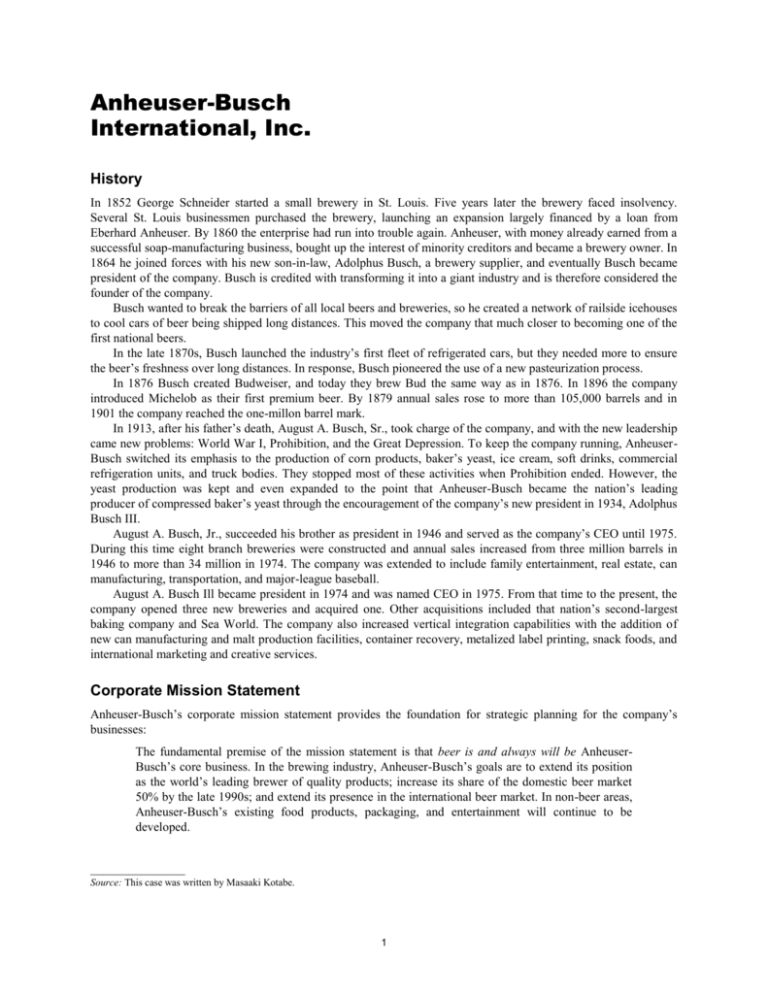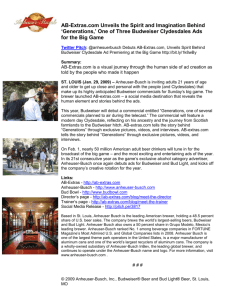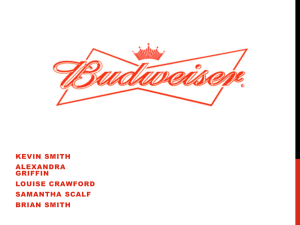Anheuser-Busch International, Inc
advertisement

Anheuser-Busch International, Inc. History In 1852 George Schneider started a small brewery in St. Louis. Five years later the brewery faced insolvency. Several St. Louis businessmen purchased the brewery, launching an expansion largely financed by a loan from Eberhard Anheuser. By 1860 the enterprise had run into trouble again. Anheuser, with money already earned from a successful soap-manufacturing business, bought up the interest of minority creditors and became a brewery owner. In 1864 he joined forces with his new son-in-law, Adolphus Busch, a brewery supplier, and eventually Busch became president of the company. Busch is credited with transforming it into a giant industry and is therefore considered the founder of the company. Busch wanted to break the barriers of all local beers and breweries, so he created a network of railside icehouses to cool cars of beer being shipped long distances. This moved the company that much closer to becoming one of the first national beers. In the late 1870s, Busch launched the industry’s first fleet of refrigerated cars, but they needed more to ensure the beer’s freshness over long distances. In response, Busch pioneered the use of a new pasteurization process. 1 In 1876 Busch created Budweiser, and today they brew Bud the same way as in 1876. In 1896 the company introduced Michelob as their first premium beer. By 1879 annual sales rose to more than 105,000 barrels and in 1901 the company reached the one-millon barrel mark. In 1913, after his father’s death, August A. Busch, Sr., took charge of the company, and with the new leadership came new problems: World War I, Prohibition, and the Great Depression. To keep the company running, AnheuserBusch switched its emphasis to the production of corn products, baker’s yeast, ice cream, soft drinks, commercial refrigeration units, and truck bodies. They stopped most of these activities when Prohibition ended. However, the yeast production was kept and even expanded to the point that Anheuser-Busch became the nation’s leading producer of compressed baker’s yeast through the encouragement of the company’s new president in 1934, Adolphus Busch III. August A. Busch, Jr., succeeded his brother as president in 1946 and served as the company’s CEO until 1975. During this time eight branch breweries were constructed and annual sales increased from three million barrels in 1946 to more than 34 million in 1974. The company was extended to include family entertainment, real estate, can manufacturing, transportation, and major-league baseball. August A. Busch Ill became president in 1974 and was named CEO in 1975. From that time to the present, the company opened three new breweries and acquired one. Other acquisitions included that nation’s second-largest baking company and Sea World. The company also increased vertical integration capabilities with the addition of new can manufacturing and malt production facilities, container recovery, metalized label printing, snack foods, and international marketing and creative services. Corporate Mission Statement Anheuser-Busch’s corporate mission statement provides the foundation for strategic planning for the company’s businesses: The fundamental premise of the mission statement is that beer is and always will be AnheuserBusch’s core business. In the brewing industry, Anheuser-Busch’s goals are to extend its position as the world’s leading brewer of quality products; increase its share of the domestic beer market 50% by the late 1990s; and extend its presence in the international beer market. In non-beer areas, Anheuser-Busch’s existing food products, packaging, and entertainment will continue to be developed. _______________ Source: This case was written by Masaaki Kotabe. 1 Anheuser-Busch International, Inc. The mission statement also sets forth Anheuser-Busch’s belief that the cornerstones of its success are a commitment to quality and maintaining the highest standards of honesty and integrity in its dealings with all stakeholders. Beer and Beer-Related Operations Anheuser-Busch, which began operations in 1852 as the Bavarian Brewery, ranks as the world’s largest brewer and has held the position of industry leader in the United States since 1957. More than four out of every ten beers sold in the United States are Anheuser-Busch products. The company’s principal product is beer, produced and distributed by its subsidiary, Anheuser-Busch, Inc. (ABI), in a variety of containers primarily under the brand names Budweiser, Bud Light, Bud Dry Draft, Michelob, Michelob Light, Michelob Dry, Michelob Golden Draft, Michelob Golden Draft Light, Busch Light, Natural Light, and King Cobra, to name just a few. In 1993 Anheuser-Busch introduced a new brand, Ice Draft from Budweiser, which is marketed in the United States and abroad as the preferred beer because it is lighter and less bitter than beer produced in foreign countries. Ice Draft from Budweiser was first introduced in the United States in late 1993 in 14 states, with a full national rollout in 1994 in the United States and abroad. Sales Anheuser-Busch achieved record sales during 1993. The increase in gross sales and net sales in 1993 as compared to 1992 was due to higher beer volume sales and higher sales by the company’s entertainment subsidiaries. ABI, the company’s brewing subsidiary and largest contributor to consolidated sales and profits, sold an industry record of 87.3 million barrels of beer in 1993, an increase of one-half of 1 percent compared to 1992 beer volume of 8.68 million barrels. The gross sales for Anheuser-Busch Companies, Inc., during 1993 were $13.19 billion, an increase of $123 million over 1992 gross sales of $13.06 billion. Gross sales for 1992 were 3.4 percent higher than for 1991. Gross sales for 1991 were $12.63 billion, an increase of 8.8 percent over 1990. Net sales for 1993 were also a record $11.51 billion, an increase of $111.6 million over 1992’s net sales of $11.39 billion. Net sales for 1992 were 3.6 percent higher than 1991. Net sales during 1991 were $11.0 billion, an increase of 2.4 percent over 1990. The company’s principal product, beer, produced and distributed by its subsidiary, ABI, sold 87.3 million barrels in 1993 as compared with 86.8 million barrels in 1992 and 86.0 million barrels in 1991. Net sales for beer and beer-related products in millions were $8,668.9 in 1993, $8,609.6 in 1992, and $8,323.5 in 1991. Anheuser-Busch International, Inc. Anheuser-Busch International, Inc. (A-BII), was formed in 1981 to explore and develop the international beer market. A-BII is responsible for the company’s foreign beer operations and for exploring and developing beer markets outside the United States. Its activities include contract and license brewing, exports, sales, marketing and distribution of the company’s beer in foreign markets, and equity partnerships with foreign brewers. A-BII has a two-pronged strategy: 1) Build Budweiser into an international brand and 2) build an international business through equity investments in leading foreign brewers. In seeking growth, Anheuser-Busch International emphasizes part ownership in foreign brewers, joint ventures, and contract-brewing arrangements. These give the company opportunities to use its marketing expertise and its management practices in foreign markets. The success of these growth opportunities depends largely on finding the right partnerships that create a net gain for both companies. Other options for international expansion include license-brewing arrangements and exporting. A-BII is currently pursuing the dual objectives of building Budweiser’s worldwide presence and establishing a significant international business operation through joint ventures and equity investments in foreign brewers. Anheuser-Busch brands are exported to more than 60 countries and brewed under Anheuser-Busch’s supervision in five countries. A-BII has experienced international growth in all operating regions with a 9 percent market share worldwide and has the largest export volume of any U.S. brewer. Anheuser-Busch had more than 45 percent of all U.S. beer exports and exported a record volume of more than 3.4 million barrels of beer in 1993. 2 Anheuser-Busch International, Inc. Market Share The top ten beer brands worldwide for 1993 in shipments and worldwide market share are as follows: Brand Budweiser Miller Lite Kirin Lager Bud Light Brahma Chopp Coors Light Heineken Antarctica Polar Asahi Super Shipments (in millions) 44.2 16.6 16.5 15.4 13.7 13.6 13.0 12.8 11.9 11.5 Company ABI Miller Brewing Co Kirin Brewery ABI Companhia Cervejaria Coors Brewing Co. Heineken NV Antarctica Paulista Cerveceria Polar SA Dry Asahi Breweries Share of world beer market in 1993 4.4% 1.7 1.7 1.5 1.4 1.4 1.3 1.3 1.2 1.2 Most recently, Anheuser-Busch has announced several agreements with other leading brewers around the world, including Modelo in Mexico and Antarctica in Brazil. These agreements are part of A-BII’s two-pronged strategy of investing internationally through both brand and partnership development. Through partnerships A-BII will continue to identify, execute, and manage significant brewing acquisitions and joint ventures, partnering with the number-one or number-two brewers in growing markets. This strategy will allow A-BII to participate in beer industries around the world by investing in leading foreign brands, such as Corona in Mexico through Modelo. A-BII’s goal is to share the best practices with its partners, allowing an open interchange of ideas that will benefit both partners. Latin America The development of Budweiser in Latin America is one of the keys to long-term growth in the international beer business as it is one of the world’s fastest growing beer markets and is a region with a growing consumer demand for beer. Anheuser-Busch products are sold in 11 Latin American countries—Argentina, Belize, Brazil, Chile, Ecuador, Mexico, Nicaragua, Panama, Paraguay, Uruguay, and Venezuela—with a total population of 346,892 million consumers. Annual Beer Sales in 1995 Country Venezuela Chile Colombia Mexico Argentina Brazil Sales (in millions) $1,015 252 898 7,610 1,096 9,676 Annual growth 52% 31 25 22 19 4 Brazil Anheuser-Busch International recently made an initial investment of 10 percent in a new Antarctica subsidiary in Brazil that consolidates all of Antarctica’s holdings in affiliated companies and controls 75 percent of Antarctica’s operations. Anheuser-Busch will have an option to increase its investment to approximately 30 percent in the new company in the future. The amount of the initial investment was approximately $105 million. The investment has established a partnership that gives Antarctica a seat on the board of Anheuser-Busch, Inc., and gives AnheuserBusch International proportionate representation on the board of the new Antarctica subsidiary. The two brewers will also explore joint distribution opportunities in the fast-growing South American beer market. According to Scott Bussen (South American representative for A-BII), A-Bll is currently in the process of signing a deal that calls for an establishment of an Anheuser-Busch-controlled marketing and distribution agreement between the two brewers to support sales of Budweiser in Brazil. 3 Anheuser-Busch International, Inc. The deal makes Anheuser-Busch the first American brewer to hold an equity stake in the Brazilian beer market, which is the largest in Latin America and the sixth-largest in the world. Last year the Brazilian beer market grew by more than 15 percent. Its potential for future growth markets is one of the most important global beer markets. The second component of the partnership will be a licensing agreement in which Antarctica will brew Budweiser in Brazil. The joint venture will be 51 percent owned and controlled by Anheuser-Busch, 49 percent by Antarctica. Antarctica’s production plants will produce Budweiser according to the brand’s quality requirements. Local sourcing of Budweiser will allow more competitive pricing and increased sales of the brand in Brazil. The agreement is expected to be signed sometime before the end of summer. Antarctica, based in São Paulo, controls more than 34 percent of the Brazilian beer market. Its annual production in 1994 was 17 million barrels of beer. Antarctica has a network of close to 1,000 Brazilian wholesalers. Budweiser has already achieved a distribution foothold in the Brazilian beer market over the past four years in cooperation with its distributor, Arisco. Brazil has a population of 158,739 million people with per capita beer consumption in Brazil estimated to be 40 liters per year. With Brazil’s population growing by 1.7 percent a year, reduced import duties, and free market reforms, Anheuser-Busch is expected to do well over the next decade in the Brazilian market. The combined strengths of Anheuser-Busch and Antarctica in the booming Brazilian environment will lead to increased sales for both companies’ products, resulting in a more competitive beer market, which benefits consumers, suppliers, and distributors in Brazil over the long term. Mexico In a further move to strengthen its international capabilities, Anheuser-Busch Companies purchased an 18 percent direct and indirect equity interest for $477 million in Grupo Modelo (located in Mexico City) and its subsidiaries, which thus far are privately held. Modelo is Mexico’s largest brewer and the producer of Corona, that country’s bestselling beer. The brewer has a 51 percent market share and exports to 56 countries. In connection with the purchases, three Anheuser-Busch representatives have been elected to the Modelo board, and a Modelo representative has been elected to serve on the Anheuser-Busch board. The agreement gives AnheuserBusch options to increase its investment in Modelo to approximately 35 percent, a minority position, and to acquire an additional minority interest in Modelo’s subsidiaries. Anheuser-Busch has an option to acquire 43.9 percent of Modelo’s voting rights by late 1997. Additionally the agreement includes the planned implementation of a program for the exchange of executives and management personnel between Modelo and Anheuser-Busch in key areas, including accounting/auditing, marketing, operations, planning, and finance. Modelo will remain Mexico’s exclusive importer and distributor of Budweiser and other Anheuser-Busch brands, which have achieved a leadership position in imported beers sold in Mexico. These brands will continue to be brewed exclusively by Anheuser-Busch breweries in the United States. Currently Anheuser-Busch brews beer for Mexico at their Houston and Los Angeles breweries, which are not very far away but do add to the markup of ABI brands. All of Modelo’s brands will continue to be brewed exclusively in its seven existing Mexican breweries and a new brewery in North Central Mexico. U.S. distribution rights for the Modelo products are not involved in the arrangement. Corona and other Modelo brands will continue to be imported into the United States by Barton Beers and Gambrinus Company and distributed by those importers to beer wholesalers. Modelo is the world’s tenth-largest brewer and, through sales of Corona, Modelo Especial, Pacifico, Negra Modelo and other regional brands, holds more than 51 percent of the Mexican beer market. Its beer exports to 56 countries in North and South America, Asia, Australia, Europe, and Africa account for more than 69 percent of Mexico’s total beer exports. Modelo is one of several companies that distribute Budweiser besides Antarctica in Brazil and other local import-export companies in other Latin American countries. Modelo is the exclusive importer and distributor of Anheuser-Busch beers in Mexico. The newest brand, Ice Draft, will be the fourth ABI brand distributed in Mexico by Modelo, joining Budweiser, Bud Light, and O’Douls. The Modelo agreement is significant because beer consumption has grown 6.5 percent annually in Mexico in the past few years. Mexico’s beer consumption is the eighth-largest in the world but still only half of U.S. consumption. The 1991 per capita beer consumption rate in Mexico was 44.3 liters, compared to 87.4 liters per person in the United States, which is high given that Mexico’s per capita income is one-tenth that of the United States. The Mexican market is expected to grow 48 percent by 1997, based on 1992 statistics. 4 Anheuser-Busch International, Inc. Anheuser-Busch does not have control over pricing. The local wholesalers and retailers set prices for Budweiser. A-BII also does not have plans to set up a full-scale production facility in Mexico at this time. Right now Budweiser is imported, which makes it two to three times higher in price than local beers. So it’s largely an upscale, niche market brand at this time. An equity arrangement in another brewery or an agreement with Modelo could lead to local production and make ABI brands more competitive with the local beer brands. Besides the 11 Latin American countries mentioned, Anheuser-Busch announced in August 1994 that it has signed agreements with the larger brewers in Costa Rica, El Salvador, Guatemala, and Honduras to distribute and market Budweiser in their respective countries. Local breweries (Cervecerma Costa Rica in Costa Rica, La Constancia in El Salvador, Cervecerma Centroamericans in Guatemala, and Cervecerma Hondureqa in Honduras) will distribute Budweiser in the 12-ounce bottles and 12-ounce aluminum cans. These distribution agreements will allow Budweiser to expand its distribution throughout the rest of Central America. These countries have an extensive national distribution network and, more important, have local market expertise to develop Budweiser throughout the region. Under the agreements, the Central American brewers will import Budweiser from Anheuser-Busch plants in Houston, Texas, and Williamsburg, Virginia. Anheuser-Busch will share responsibility for Budweiser’s marketing with each of its Central American partners, supported by nationwide advertising and promotional campaigns. Advertising Event sponsorship Given Budweiser’s advertising approach traditionally built around sports, the decision to hold the 1994 World Cup tournament in the United States gave A-BII a perfect venue to pitch Budweiser to Latin Americans. The company signed a multimillion-dollar sponsorship deal with the World Cup Organizing Committee, making Budweiser the only beer authorized to use the World Cup logo. “The World Cup has become a vehicle for us to reach Latin America,” said Charlie Acevedo, director of Latin American marketing for Anheuser-Busch International. For ten months, soccer fans in South America saw the Bud logo on everything from soccer balls to beer glasses. Soccer fans collected a World Cup bumper sticker when they purchased a 12-pack of Bud. When they watched the game on television, they saw Budweiser signs decorating the stadiums and a glimpse of the Bud blimp hovering overhead. According to Charlie Acevedo, the goal is to make Budweiser a global icon, like McDonald’s golden arches or Coca-Cola. Anheuser-Busch just signed its second two-year agreement with ESPN Latin America. “Being able to buy on a regional basis gives a consistent message that is very reasonable in terms of cost,” said Steve Burrows, A-BII’s executive vice president of marketing. Latin America offers promise with its youthful population and rising personal income. Half of Mexico’s population is under 21, and other Latin American countries have similar profiles, offering opportunities for advertisers to reach the region’s 444.3 million population. The biggest new advertising opportunities in the Latin American market are Fox Latin America, MTV Latino, Cinemax Ole (a premium channel venture with Caracas cable operator Omnivision Latin American Entertainment), USA Network, and Telemundo (a 24-hour Spanish-language news channel). Marketers will have yet another panregional advertising option. Hughes (the U.S. aerospace company) and three Latin American partners— Multivision in Mexico, Televisao Abril in Brazil, and the Cisneros Group in Venezuela—launched a $700 million satellite that will beam programs in Spanish and Portuguese into homes across the continent. The service is called DirectTV. Because of this satellite, Central and South America have added 24 new channels; with digital compression technology, its capability could reach 144 cable channels. In the past Anheuser-Busch used CNN international as its only ad vehicle, but with all the new opportunities, “the company will begin adding a local media presence throughout Latin America,” said Robert Gunthner, A-BIl’s vice president of the Americas region. Anheuser-Busch will be using ads originally aimed at U.S. Hispanics, most of which were created by Carter Advertising of New York. A-BII will let the local agencies pick its messages, customize advertising, and do local media planning. In the past, there has been much criticism toward ABI’s ethnocentric approach toward marketing Budweiser; however, because of the world obsession with American pop culture, they feel they don’t need to tone down their American image. In Costa Rica, A-BII will use JBQ, San Jose; in El Salvador, Apex/BBDO, San 5 Anheuser-Busch International, Inc. Salvador; in Guatemala, Cerveceria’s in-house media department; and in Honduras, McCann-Erickson Centroamericana, San Pedro. Penetration of Paid Cable TV Channels Location Brazil Mexico Argentina Chile Venezuela Uruguay Ecuador Paraguay TV households (in millions) 30.0 14.0 9.0 3.4 3.3 0.7 0.5 0.5 Paid subscribers 330,000 1,700,000 4,300,000 200,000 90,000 35,000 25,000 45,000 Penetration rate 15% 12 47 6 3 5 5 9 Imported beers cost two or three times as much as locally brewed beers in South America. But thanks to cable television and product positioning in U.S. movies, Budweiser was already a well-known brand in South America when the company began exporting to the continent. Strategy According to Charlie Acevedo, Anheuser-Busch has seen double-digit increases in Latin American sales in the past five years. The gains came from both an increase in disposable income and increasingly favorable attitude toward U.S. products, especially in Argentina, Brazil, Chile, and Venezuela. Because Latin America has a very young population, Anheuser-Busch expects this market to grow at 4 percent annually. Furthermore, with NAFTA and a free trade zone, the company expects to see a significant rise in personal income in Latin American countries, which translates to great growth potential for Anheuser-Busch brands. North American products and lifestyles are very much accepted in South America, but beer consumption still lags far behind U.S. levels. Argentines consume about 30 liters annually per capita, Brazilians 40 liters, Chileans 35 liters, and Venezuelans 65 liters, compared to 90 liters per person annually in the United States. “The international focus will be almost completely on Budweiser, because there is a worldwide trend toward less-heavy, less-bitter beers,” said Jack Purnell, chair and chief executive officer of Anheuser-Busch International. They’re counting on the American image to carry their beer, therefore opting for a universal campaign with American themes as opposed to tailoring Budweiser’s image for local markets. In the past ABI has tinkered with its formula and marketed Budweiser under different names to give a local flavor to their beer but had absolutely no success. Purnell said, “What the market does not need is an American brewer trying to make up from scratch, new European-style beers. Bud should be Bud wherever you get it.” Opportunities Mexico offers the U.S. exporter a variety of opportunities encompassing most product categories. Mexico is continuing to open its borders to imported products. Mexico’s population of approximately 92 million is the eleventh-largest in the world and the third largest in Latin America (after Brazil and Argentina). Mexico is a young country, with 69 percent of its population under 30 years of age. In addition the Mexican government has adopted new privatization policies decreasing its involvement in the country’s economy. As a result private resources, both local and foreign, are playing a greater role in all areas of the Mexican economy. NAFTA, which aims to eliminate all tariffs on goods originating from Canada and the United States, is expected to create a massive market with more than 360 million people and $6 trillion in annual output. Demographics Mexico’s overall population in 1994 was estimated at 92.2 million people. Based on 1990 statistics, the age breakdown is as follows: under 15, 38.3 percent; 15–29, 29.4 percent; 30–44, 16.6 percent; 45–59, 8.9 percent; 60– 74, 4.5 percent; 75 and over, 1.7 percent. In 1994 the average age of the Mexican population was 23.3 years. 6 Anheuser-Busch International, Inc. Between 1970 and 1990 the ratio of the population living in localities with between 100,000 and 500,000 inhabitants grew from 12 to 22 percent. This was largely due to rural-urban migration. More than 71 percent of the population lives in urban areas of Mexico. In 1990, 22 percent of the national population lived in Mexico City and the State of Mexico. The Mexican population is expected to rise to 102.9 million in the year 2000 and to 112.9 million in the year 2010. 7





